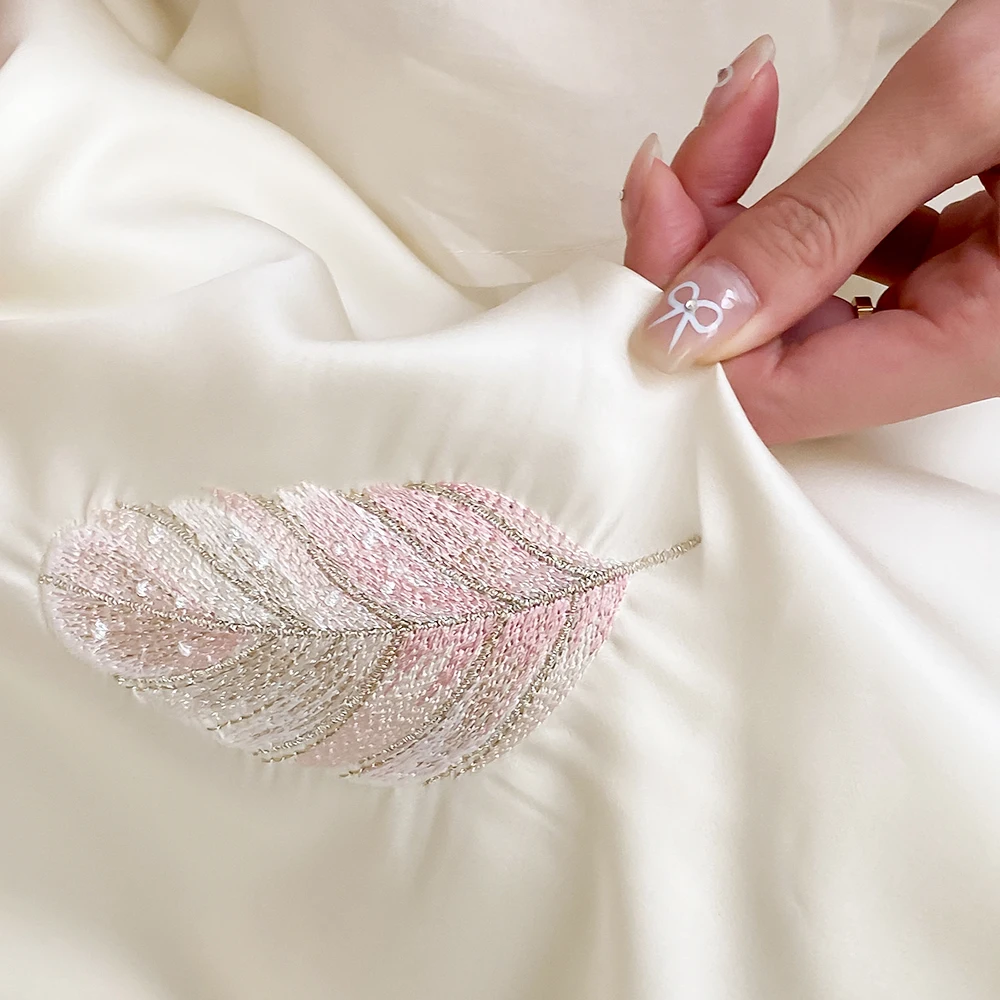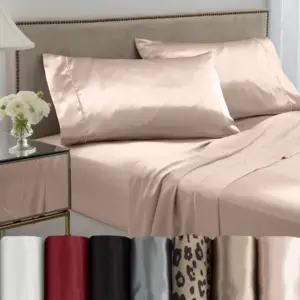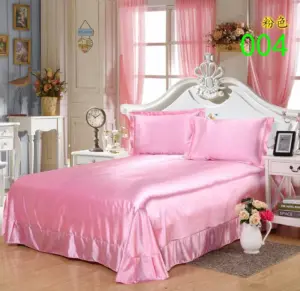Introduction: The Timeless Alliance of Silk and Color in Bedroom Design
Few materials transform a bedroom quite like silk. This premium fabric has adorned the chambers of royalty for centuries, not merely as a status symbol, but because silk possesses unique properties that elevate any color scheme to extraordinary heights. The magic lies in silk’s natural sheen – the way it catches light creates depth and dimension that other fabrics simply cannot replicate.
When designing a bedroom, the colors you choose set the foundation for your sanctuary, but the materials you select determine how those colors are experienced. Silk’s remarkable light-reflecting properties make blues appear deeper, neutrals more sophisticated, and warm tones more inviting. This transformative quality creates endless possibilities for your personal retreat.
In this guide, we’ll explore how silk enhances three main color palettes: cool and calming schemes that promote tranquility, warm and welcoming tones that create comfort, and bold dramatic statements that showcase personality. You’ll discover how to harness silk’s unique properties to create a bedroom that’s not just beautiful, but transformative.
The exceptional quality of Mulberry silk, with its superior sheen and smoother texture, makes it particularly effective for matching silk bedding colors with your overall design vision. Whether you’re drawn to crisp whites or rich jewel tones, mulberry silk bedding sets provide the perfect canvas for your color story.
Understanding Silk’s Unique Influence on Color Perception and Mood
Light Interaction
Silk possesses a natural luminosity unlike any other fabric. Its fibers reflect light in multiple directions, creating that characteristic sheen we associate with luxury. This reflective quality means colors appear more dynamic on silk – shifting subtly as light conditions change throughout the day. Morning sunlight brings out different tones than evening lamplight, giving silk-adorned bedrooms an ever-changing character.
Color Depth
The smooth surface of silk creates a more intense color experience. While cotton absorbs light, silk reflects it – making colors appear richer and more saturated. A forest green silk pillow will have noticeably more dimension than the same color in cotton, with highlights that seem to glow from within. This natural enhancement means you can achieve dramatic effects with even subtle color palettes.
Texture Effects
Silk’s exceptionally smooth texture creates a continuous surface for light reflection. Unlike rougher fabrics that scatter light diffusely, silk’s uniform surface produces cleaner color representation. This smoothness also creates a visual softness that affects how we perceive the color – even dark colors feel less heavy when rendered in silk.
Practical Benefits
Beyond aesthetics, silk offers temperature-regulating properties that complement its visual appeal. The fabric naturally adjusts to body temperature, feeling cool in summer and warm in winter. Understanding the relationship between momme vs thread count helps in selecting the perfect weight of silk for your bedroom. Higher momme weights (22-25) create slightly more substantial draping and color depth, while lighter weights (19-22) offer a more delicate appearance.
Psychological Impact
The combination of silk’s gentle touch and visual richness creates a multisensory experience that enhances relaxation. Colors rendered in silk tend to feel more sophisticated and intentional, creating an atmosphere of mindful luxury. This sensory richness is particularly beneficial in the bedroom, where tactile comfort and visual calm should merge to promote restful sleep.
The exceptional quality of 100% silk sheets maximizes these benefits, creating a foundation for color schemes that aren’t just seen, but truly felt.
Cool and Serene Sanctuaries: Calming Color Schemes with Silk
Cool-toned color schemes create bedroom environments that promote deep relaxation and tranquility. When rendered in silk, these palettes take on additional serenity through the fabric’s natural luminosity. The following cool-toned silk combinations create particularly effective sleep sanctuaries:
Pure Whites & Soft Neutrals
White and ivory silk creates an atmosphere of cloud-like serenity. Unlike stark cotton whites that can feel clinical, white silk maintains a soft luminosity that feels both pure and inviting. Consider:
– Ivory silk bedding with soft grey accents and minimal natural wood elements
– Winter white silk sheets paired with pale silver decorative pillows
– Cream silk duvet with subtle texture variations in similarly neutral tones
The reflective quality of silk prevents white schemes from appearing flat or sterile, instead creating a multidimensional backdrop for restful sleep.
Blues & Aquas
Blue silk embodies tranquility like no other combination, drawing on associations with clear skies and calm waters. Silk enhances blue’s natural serenity by adding depth and subtle variation:
– Powder blue silk bedding with white and silver accents
– Aquamarine silk pillowcases against crisp white sheets
– Navy silk accent pieces in an otherwise pale blue and grey room
Blue silk schemes work particularly well in bedrooms that receive morning light, as the fabric will showcase subtle variations throughout the day.
Cool Greys & Silvers
Grey silk creates a sophisticated neutral foundation that’s more interesting than beige but just as versatile. The reflective quality of silk elevates grey from ordinary to extraordinary:
– Platinum silk sheets with darker charcoal accents
– Silver-grey silk duvet with white pillows and minimal black details
– Dove grey silk bedding with pale blue and white companions
Grey silk serves as an excellent foundation for minimalist bedroom designs where texture becomes more important than color variation.
Soft Greens & Sage Tones
Green silk brings the refreshing essence of nature indoors while maintaining a cool, tranquil feeling:
– Sage silk bedding with ivory and natural linen accents
– Mint green silk pillowcases against white bedding for a subtle refresh
– Seafoam green silk throws as accents in an otherwise neutral room
Green silk schemes create a connection to the natural world while maintaining the sophisticated quality silk brings to any color.
Lavenders & Lilacs
Soft purple tones in silk create a gently feminine space without becoming overly sweet:
– Pale lavender silk bedding with grey and silver accents
– Lilac silk pillowcases against white sheets for a subtle color statement
– Periwinkle silk accents in a predominantly white and neutral bedroom
Learning to coordinate silk sheet colors with other bedroom elements ensures your cool-toned sanctuary maintains perfect harmony. For a pure foundation, white silk sheets offer versatility while grey silk sheets provide sophisticated depth.

Practical Applications: Cool-Toned Silk in Bedroom Elements
Translating color concepts into real-world bedroom designs requires thoughtful planning. Here’s how to incorporate cool-toned silk throughout your bedroom for maximum impact:
Bedding Essentials
Cool-toned silk bedding forms the centerpiece of a serene bedroom design:
– Layer different shades of the same cool color (light blue sheets with navy accents) for depth
– Create contrast with white silk sheets and colored silk pillowcases
– Use a cool-toned silk duvet cover as your main color statement, supported by neutral accessories
– Consider seasonal switches – lighter blues and silvers for summer, deeper teals or greys for winter
Window Treatments
Silk curtains in cool tones filter light in uniquely flattering ways:
– Pale blue silk curtains diffuse sunlight to create a gentle, ethereal glow
– Silver-grey silk drapes add sophistication while maintaining light flow
– Layered sheer and opaque cool-toned silk creates adjustable light control
– Consider lining silk curtains to protect the color from sun damage over time
Accent Pieces
Strategic placement of silk accents creates focal points:
– Silk throw pillows in varying cool shades and textures
– A draped silk throw at the foot of the bed introduces subtle color variation
– Silk-covered lampshades cast flattering, diffused light in cool tones
– Framed silk fabric as wall art brings texture to vertical surfaces
Texture Mixing
Cool-toned silk pairs beautifully with complementary textures:
– Contrast silk’s smoothness with natural linen or cotton accessories
– Pair cool silk with light-toned woods for an organic modern feel
– Add glass or crystal elements to enhance silk’s reflective qualities
– Incorporate brushed metals (silver, chrome) to complement cool silk tones
In smaller bedrooms, cool-toned silk helps create a sense of space and openness. The fabric’s reflective quality bounces light around the room, while cool colors recede visually, making the room feel larger.
Incorporating silk into your bedroom design with silk linens allows for color exploration without overwhelming the space. Start with smaller elements like silk pillowcases to introduce cool tones before committing to larger silk investments.
Warm and Inviting Retreats: Rich Color Schemes with Silk
Warm-toned silk creates bedroom environments that feel embracing and secure – perfect for creating cozy retreats that still maintain sophistication. The luminous quality of silk elevates warm colors from merely cozy to truly luxurious:
Golden Hues & Champagnes
Gold-toned silk creates a subtle radiance that feels both luxurious and welcoming:
– Champagne silk bedding with ivory and soft gold accents
– Honey-gold silk throws against neutral bedding for a warm highlight
– Pale gold silk pillowcases paired with white sheets and natural textures
– Antique gold silk curtains filtering light to cast a warm glow across the room
These golden tones in silk create a year-round warmth that feels sophisticated rather than seasonal.
Terracottas & Rust Tones
Earthy warm tones rendered in silk take on unexpected richness:
– Terracotta silk bedding with cream and chocolate brown accents
– Rust silk pillows against neutral bedding for southwestern warmth
– Clay-colored silk curtains creating a sunset glow as light filters through
– Cinnamon silk throws adding spice to otherwise neutral bedrooms
The sheen of silk prevents these earthy tones from appearing flat or dull, instead giving them a vibrant character.
Soft Pinks & Corals
Pink silk creates spaces that feel nurturing without being overly feminine:
– Blush silk bedding with grey and ivory accents for sophisticated warmth
– Coral silk pillowcases bringing life to white or neutral bedding
– Rose-gold silk accents adding warmth to grey or taupe bedrooms
– Salmon pink silk throws creating focal points in neutral spaces
Pink tones in silk take on a sophisticated quality, shedding juvenile associations through the material’s natural elegance.
Rich Caramels & Toffees
These mid-tone neutrals gain extraordinary depth when rendered in silk:
– Caramel silk sheets with cream and chocolate accents for layered warmth
– Toffee-colored silk duvet covers creating rich, inviting focal points
– Butterscotch silk pillows adding warmth to grey or blue bedrooms
– Amber silk curtains creating a honey-like glow as light filters through
These colors bridge true neutrals and statement shades, offering warmth without overwhelming the space.
Warm Greys & Taupes
Grey isn’t exclusively cool – warm-leaning greys in silk create sophisticated coziness:
– Greige silk bedding (grey with beige undertones) for subtle warmth
– Taupe silk sheets paired with deeper brown accents
– Mushroom-colored silk throws adding dimension to neutral bedding
– Putty-colored silk curtains creating soft, diffused light
When choosing perfect silk bedding colors in warm tones, consider your room’s lighting conditions and existing wood tones. For gentle warmth that works in any setting, pink silk sheets provide versatile elegance.
Practical Applications: Warm-Toned Silk in Bedroom Elements
Implementing warm silk tones throughout your bedroom creates a cohesive retreat that feels both luxurious and comforting. Here’s how to incorporate these colors effectively:
Luxurious Bedding
Warm-toned silk bedding creates an inviting sleep environment:
– Layer complementary warm tones (champagne sheets with caramel pillows)
– Create subtle contrast with varying intensities of the same warm color
– Use piping or borders in contrasting colors to define warm silk bedding
– Introduce pattern through subtly textured silk (jacquard or damask weaves)
Drapery & Window Treatments
Silk curtains in warm tones transform natural light into golden ambiance:
– Champagne silk curtains soften harsh daylight into flattering warmth
– Amber or honey-toned silk creates a perpetual sunset glow
– Layer sheer and opaque warm-toned silks for adjustable light filtering
– Consider silk curtains with subtle pattern or texture for added dimension
Upholstered Elements
Extend warm silk tones to furniture pieces for cohesive luxury:
– Headboards upholstered in warm-toned silk make dramatic yet sophisticated statements
– Bedroom benches or ottomans in complementary silk tones
– Silk-covered lampshades cast golden, flattering light throughout the room
– Silk-wrapped bulletin boards or wall panels add texture and sound absorption
Layering Techniques
Creating depth with multiple warm silk elements:
– Combine similar tones in different silk finishes (matte, lustrous, textured)
– Layer transparent silk over opaque elements for dimensional color effects
– Mix silk with complementary warm-toned materials like velvet or brushed cotton
– Create ombré effects with graduated warm tones from light to dark
For seasonal adaptation, warm-toned silk can be layered differently throughout the year – more abundantly in winter for coziness, more selectively in summer for touches of warmth without heaviness.
Exploring silk bedding bedroom decor ideas reveals countless ways to incorporate warm silk tones into your personal sanctuary, from subtle accents to statement pieces.
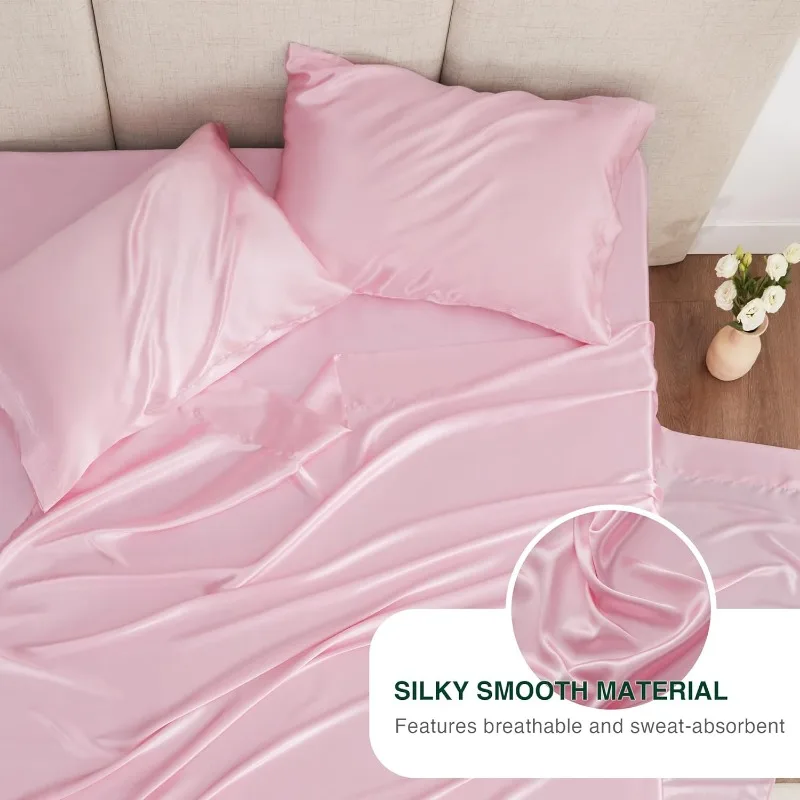
Bold Statements & Jewel Tones: Dramatic Color Schemes with Silk
For those seeking to create distinctive, memorable bedrooms, bold jewel tones rendered in silk offer unmatched dramatic impact. The natural luminosity of silk enhances these rich colors, creating spaces with depth and character:
Emerald & Forest Greens
Deep greens in silk create spaces that feel both luxurious and connected to nature:
– Emerald silk bedding with gold and ivory accents for regal elegance
– Forest green silk pillows against neutral bedding for concentrated color impact
– Jade silk accents introducing vibrant energy to neutral spaces
– Olive silk curtains filtering light through a rich natural lens
Green silk’s reflective qualities create subtle variations across its surface, giving these rich tones beautiful dimension.
Sapphire & Navy Blues
Deep blues rendered in silk create sophisticated sanctuaries:
– Navy silk bedding with silver or white accents for timeless elegance
– Royal blue silk pillowcases against white sheets for concentrated color
– Indigo silk throws adding rich color to neutral bedrooms
– Midnight blue silk curtains creating a cocoon-like atmosphere
The reflective quality of silk prevents dark blues from feeling heavy or overwhelming.
Ruby & Burgundy Reds
Red silk introduces passionate energy while maintaining sophistication:
– Burgundy silk bedding with gold and cream accents for opulent warmth
– Ruby silk pillows against neutral bedding for dramatic focal points
– Cranberry silk throws adding rich color without dominating
– Garnet silk curtains diffusing light through a warm, intimate filter
Silk’s natural sheen softens red’s intensity while maintaining its vibrant character.
Amethyst & Plum Purples
Purple silk creates spaces that feel creative and distinctive:
– Plum silk bedding with silver and pale lavender accents
– Amethyst silk pillowcases against white or grey sheets
– Aubergine silk throws adding rich depth to neutral bedrooms
– Violet silk accent pieces introducing creative energy
Purple in silk takes on remarkable depth, with highlights and shadows creating almost three-dimensional color.
Sophisticated Black
Black silk transforms what could be stark into something sumptuous:
– Black silk bedding with gold or silver accents for dramatic luxury
– Charcoal silk with slightly lighter grey companions for subtle depth
– Black silk pillowcases against white sheets for graphic contrast
– Onyx silk curtains creating a cocoon-like retreat
The reflective nature of silk gives black a dimensional quality impossible in matte fabrics, creating depth rather than flatness.
Luxury silk bedding sets offer the perfect foundation for these dramatic color statements, while green silk sheets provide a versatile entry into bold bedroom design that connects with nature while making a statement.
Practical Applications: Bold Silk Colors in Bedroom Elements
Implementing bold silk colors requires thoughtful balance. Here’s how to incorporate dramatic silk tones effectively:
Statement Bedding
Bold silk bedding becomes your room’s centerpiece:
– Make the bed the focal point with rich jewel-toned silk sheets or duvet covers
– Balance bold silk bedding with neutral walls and furnishings
– Use contrast piping or borders to frame and contain bold colors
– Layer different tones of the same bold color family for sophisticated depth
Accent Integration
Strategic bold silk accents energize neutral spaces:
– Introduce emerald or sapphire silk pillows to neutral bedding
– Drape a ruby silk throw across a neutral bed or chair
– Use bold silk curtain tiebacks against neutral drapes
– Place amethyst silk-covered boxes or trays on nightstands
Color Blocking
Create intentional color sections with bold silk:
– Define zones with different jewel tones (sapphire bed area, emerald seating area)
– Frame bold silk elements with neutral borders to contain visual energy
– Create geometric patterns with bold silk panels on walls or headboards
– Layer transparent bold silk over neutral elements for dimensional color
Balancing Techniques
Prevent bold silk colors from overwhelming:
– Limit bold colors to 10-30% of the visual field
– Balance with plenty of neutral space to give the eye rest
– Use metallics (gold, silver, bronze) as transitional elements between bold colors
– Echo bold colors in subtle ways throughout the room (tiny emerald detail in artwork echoing emerald silk pillows)
Light Management
Control lighting to showcase dramatic silk colors:
– Position directional lighting to highlight the dimensional quality of bold silk
– Consider how natural light interacts with jewel-toned silk throughout the day
– Use dimmers to adjust the intensity of bold silk colors for different moods
– Experiment with color temperature of bulbs (warm vs. cool light) to enhance specific jewel tones
Exploring the full range of silk bedding color options helps you determine which bold choices best express your personal style while creating a harmonious bedroom environment.
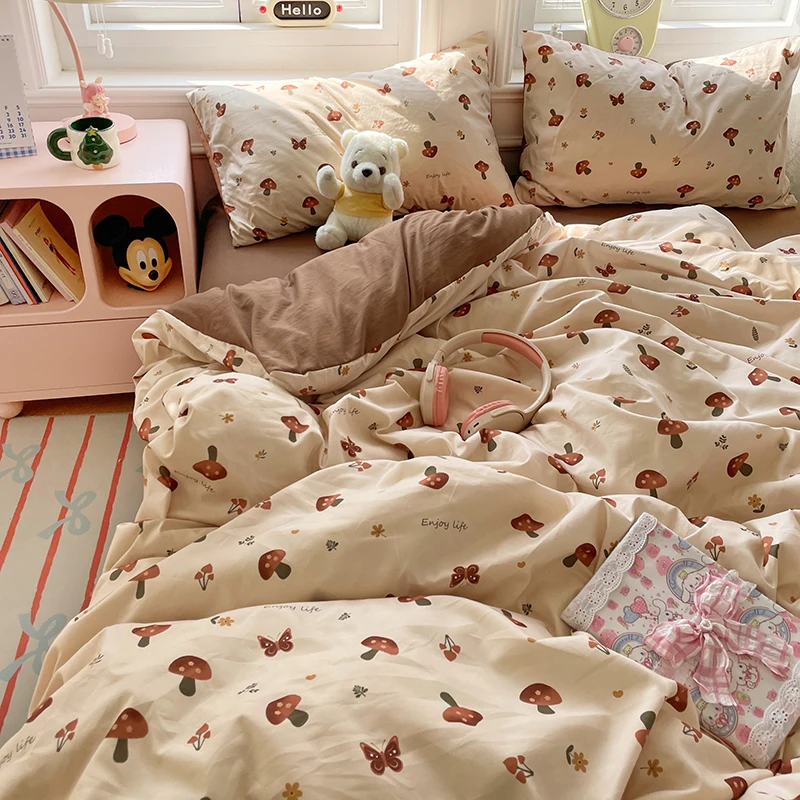
Essential Design Principles for Silk-Enhanced Color Schemes
Creating successful silk-enhanced bedrooms requires understanding key design principles that ensure balance and harmony:
The 60-30-10 Rule
This classic interior design principle works beautifully with silk:
1. 60% of the visual space should be your dominant color (often walls and large furniture)
2. 30% should be your secondary color (typically bedding and window treatments)
3. 10% should be accent colors (pillows, art, accessories)
With silk, consider using this luxurious fabric for either the 30% secondary component or the 10% accent layer for maximum impact without overwhelming the space.
Color Temperature Balance
Creating harmony between warm and cool elements:
– Pair cool-toned silk with warm wood finishes for natural balance
– Use warm-toned silk accents to soften predominantly cool rooms
– Create transitions between temperature extremes with neutral silk elements
– Consider the natural light in your room – north-facing rooms benefit from warm silk tones, while south-facing rooms can handle cooler silk hues
Texture Contrast
Silk’s smooth character requires complementary textures:
– Balance silk’s refinement with natural, rougher textures like linen or wool
– Pair silk with matte finishes to highlight its natural luminosity
– Introduce tactile variety through velvet, cashmere, or brushed cotton companions
– Use textured walls or floors to ground glossy silk elements
Lighting Considerations
Optimizing light to showcase silk’s reflective qualities:
– Position beds to capture natural light that enhances silk’s sheen
– Use multiple light sources at different heights to create dimensional highlights on silk
– Consider how seasonal light changes will affect silk color perception
– Install dimmers to adjust the drama of silk’s reflective qualities
Scale & Proportion
Determining appropriate amounts of silk based on room size:
– Larger rooms can handle more silk surface area without feeling overwhelming
– In smaller spaces, use silk selectively for maximum impact
– Scale silk pattern sizes (if using patterned silk) to your room dimensions
– Consider the visual weight of different silk colors – dark silk reads as “heavier”
Seasonal Adaptability
Creating silk-enhanced schemes that transition well:
– Layer silk elements that can be added or removed seasonally
– Choose silk colors with year-round appeal for major investments like headboards
– Use silk accessories to introduce seasonal color shifts
– Consider silk weight (momme) appropriate for seasonal comfort
Understanding whether bedding should match wall color helps create cohesive silk-enhanced bedrooms that feel intentional rather than accidental.
Practical Guide: Creating Your Perfect Silk Color Scheme
Follow these steps to develop a personalized silk color scheme that transforms your bedroom:
Step 1: Define Your Goal
Determine the mood you want to create:
– Tranquil retreat: Cool silks in blues, greens, or soft neutrals
– Warm sanctuary: Amber, blush, or terracotta silk tones
– Dramatic statement: Jewel-toned silks like emerald, sapphire, or amethyst
– Timeless elegance: Classic ivory, champagne, or grey silks
Consider how you want to feel in the space and what atmosphere promotes your best rest.
Step 2: Assess Your Space
Evaluate your bedroom’s existing conditions:
– Measure natural light quality and direction (north-facing rooms are cooler, south-facing warmer)
– Note fixed elements that must be incorporated (floor color, architectural features)
– Determine your room’s size and ceiling height (smaller spaces generally benefit from lighter silk tones)
– Consider existing furniture that will remain in the space
Step 3: Select Your Base Color
Choose the primary silk color that will dominate:
– For bedding-focused schemes, this is your sheet or duvet color
– For drapery-focused schemes, this is your curtain color
– Select a color that works with your fixed elements and lighting conditions
– Consider your base color’s versatility across seasons
100% Silk Sheets, Green Silk Sheets, King Size Silk Bedding Set, Mulberry Silk Bedding Sets, Queen Size Silk Bedding Set
Price range: $1,246.21 through $1,615.22 Select options This product has multiple variants. The options may be chosen on the product pagePink Silk Sheets, Twin Size Silk Sheets
$171.80 Select options This product has multiple variants. The options may be chosen on the product pageFull-size Silk Sheets, Pink Silk Sheets
$136.31 Select options This product has multiple variants. The options may be chosen on the product pageGrey Silk Sheets, Silk Sheet and Pillowcase Set
Price range: $88.20 through $146.64 Select options This product has multiple variants. The options may be chosen on the product page100% Silk Sheets, King Size Silk Bedding Set, Mulberry Silk Bedding Sets, Queen Size Silk Bedding Set, White Silk Sheets
Price range: $1,000.79 through $1,351.42 Select options This product has multiple variants. The options may be chosen on the product pageKing Size Silk Sheets, Pink Silk Sheets, Silk Flat Sheets
$132.96 Select options This product has multiple variants. The options may be chosen on the product page
Step 4: Build Your Palette
Add complementary colors that enhance your silk selection:
– Choose 2-3 companion colors that harmonize with your base silk color
– Include at least one neutral tone to provide visual rest
– Consider the color wheel for guidance (complementary, analogous, or triadic schemes)
– Select colors with similar saturation levels for cohesive feel
Step 5: Plan Your Implementation
Decide which bedroom elements will feature silk:
– Prioritize items that showcase silk’s unique properties (bedding, pillows, curtains)
– Balance silk with other textures throughout the room
– Consider your budget and allocate for maximum impact
– Plan implementation phases if doing a gradual transformation
Step 6: Test Before Committing
Sample before making major investments:
– Order silk swatches or smaller items (pillowcases) before full bedding sets
– Test samples in your actual space under different lighting conditions
– Place samples against existing elements to ensure harmony
– Live with samples for a few days to ensure you enjoy the colors over time
Step 7: Create Balance
Ensure harmonious distribution of colors and textures:
– Apply the 60-30-10 rule to maintain visual balance
– Distribute your chosen colors throughout the room (avoid concentrating all blue in one corner)
– Balance silk’s glossy texture with matte companions
– Create focal points with your most dramatic silk elements
For additional inspiration, explore creative approaches to styling silk sheets that complement your chosen color scheme.
Care and Maintenance of Silk in Your Color Scheme
Preserving the beauty of your silk color scheme requires proper care:
Color Preservation
Techniques to prevent fading:
– Keep silk bedding and curtains away from direct sunlight when possible
– Line curtains with light-protective backing to prevent sun damage
– Rotate silk items regularly to ensure even exposure
– Choose window treatments that filter UV rays which cause fading
Cleaning Considerations
Appropriate cleaning methods that protect silk’s color and texture:
– Hand wash colored silk in cold water with pH-neutral detergent
– Turn colored silk items inside out before washing
– Never use bleach or harsh chemicals on silk
– Test any cleaning product on an inconspicuous area first
– Consider professional cleaning for large silk items like duvets
Storage Solutions
Proper storage to maintain silk’s appearance:
– Store silk in breathable cotton bags, never plastic
– Avoid folding silk along the same lines repeatedly to prevent permanent creases
– Keep silk away from direct sunlight during storage
– Use acid-free tissue paper when storing folded silk items
– Ensure storage areas are cool, dry, and free from moths
Extending Longevity
Tips for maximizing silk’s lifespan:
– Rotate silk bedding regularly to distribute wear
– Remove jewelry before handling silk to prevent snags
– Address spills immediately with gentle blotting (never rubbing)
– Iron silk on the lowest setting while still slightly damp, using a pressing cloth
– Consider silk pillowcase rotation to maintain color consistency
Understanding how to maintain silk bedding for year-round comfort ensures your color scheme remains vibrant and beautiful through all seasons.
Frequently Asked Questions About Silk Color Schemes
Do silk colors look different in various lighting?
Yes, silk colors appear notably different depending on lighting conditions. Natural daylight reveals silk’s true color most accurately, while incandescent lighting adds a warm glow that enhances gold and red undertones. LED lighting can either cool or warm colors depending on the bulb’s color temperature. Before finalizing your silk color scheme, test samples under the specific lighting conditions in your bedroom, viewing them at different times of day to understand how they’ll transform.
Can I mix different colors of silk in one bedroom?
Absolutely! Mixing silk colors adds dimension and interest, but follow these guidelines for harmony: choose colors with similar undertones (all warm or all cool), maintain consistent silk quality across different colored pieces, and use the 60-30-10 rule to create visual hierarchy. Using different silk colors for sheets, pillowcases, and throws creates beautiful layered effects while maintaining cohesion.
Will silk make my small bedroom feel cramped?
When used thoughtfully, silk can actually make small bedrooms feel more spacious. Light-reflecting silk in pale tones (ivory, silver, light blue) bounces light around the room, creating an airier feel. Avoid overwhelming a small space with too much silk – instead, use it strategically for maximum impact. Consider silk pillowcases or a silk-trimmed duvet rather than floor-to-ceiling silk curtains in compact spaces.
How do I match silk colors to existing furniture?
Look for undertones in your furniture pieces to guide silk color selection. For dark wood furniture with warm undertones, champagne, gold, or coral silk creates harmony. For cool-toned woods or painted furniture, consider blue, silver, or lavender silk companions. When working with neutral furniture, silk offers an opportunity to introduce color personality – the best color silk bed sheets complement rather than match existing furniture for a designed-not-decorated look.
Are certain silk colors better for seasonal changes?
Mid-tone silks like taupe, sage green, and soft blue work beautifully year-round. However, if you prefer seasonal adjustments, consider a neutral silk foundation (ivory sheets, for instance) with changeable accents – emerald or burgundy silk pillows for winter, aqua or coral for summer. Some silk colors, particularly jewel tones, can feel seasonally specific, so consider your climate and preferences before investing in dramatically colored major silk pieces.
Does silk create a formal atmosphere?
Silk can create elegance without formality when styled appropriately. While traditional shiny silk in deep colors (ruby red, royal blue) tends toward formality, many silk finishes and colors create relaxed luxury instead. Matte silk finishes in natural tones (oatmeal, soft green) feel sophisticated yet approachable. The styling matters as much as the silk itself – relaxed, slightly rumpled silk bedding feels invitingly casual while perfectly pressed silk appears more formal.
Conclusion: Transform Your Bedroom with Strategic Silk Color Schemes
The marriage of thoughtfully chosen colors with silk’s luminous quality creates bedroom environments that transcend ordinary design. By understanding silk’s unique properties – its light reflection, texture, and depth – you can create spaces that don’t just look beautiful but feel transformative.
The principles we’ve explored work regardless of your color preferences. Whether you’re drawn to serene blues, warming ambers, or dramatic jewel tones, silk elevates these choices from merely decorative to truly experiential. The result is a bedroom that feels intentionally crafted rather than simply decorated.
If you’re new to incorporating silk into your color scheme, start with smaller elements like pillowcases or throws before committing to larger investments. This allows you to experience silk’s transformative qualities while gradually developing your personal silk color strategy.
Remember that the most successful bedrooms speak to individual preferences while honoring design principles. Your perfect silk color scheme is the one that creates your ideal sanctuary – a space that welcomes you at day’s end and renews you each morning with its beauty, comfort, and harmony.

